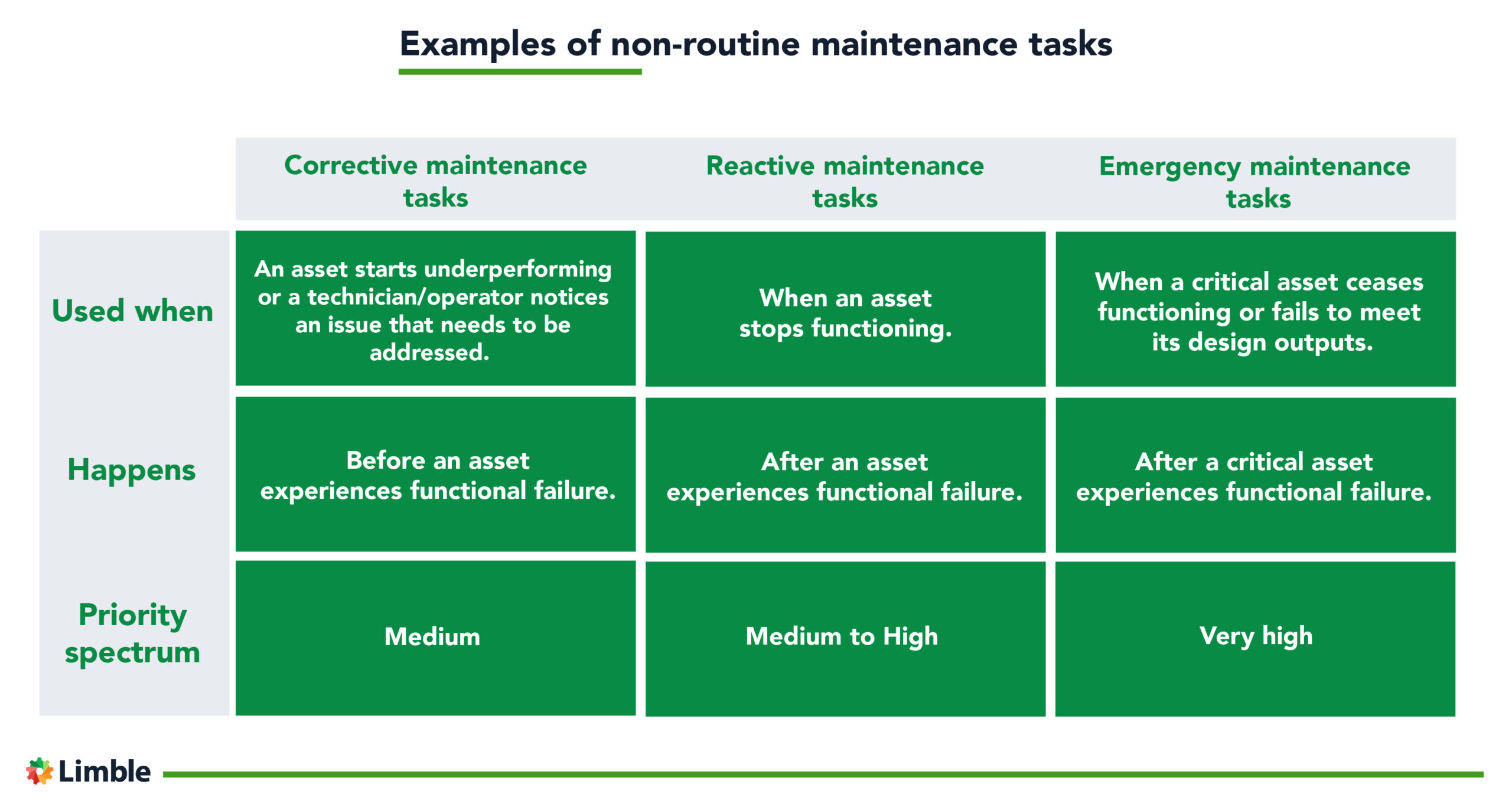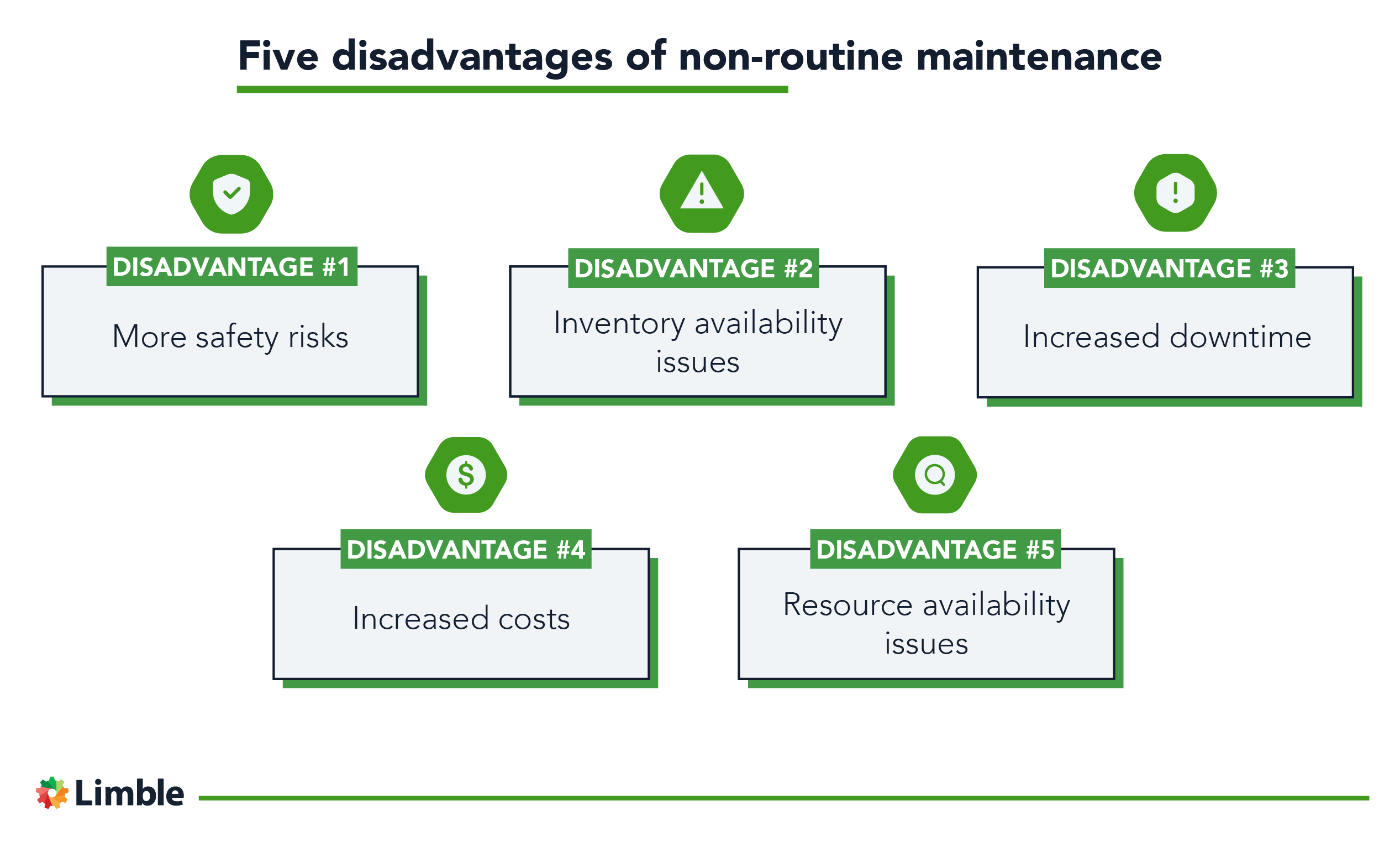Non-routine maintenance, in contrast to routine maintenance, refers to maintenance tasks without a predetermined frequency. Even though non-routine maintenance has a place in all maintenance programs, it brings a range of issues you need to stay on top of.
In this post, we’ll discuss the disadvantages of non-routine maintenance, single out some examples, and explain how you can simplify non-routine maintenance with a CMMS.
Let’s start with the examples.
Examples of non-routine maintenance tasks
The three main types of non-routine maintenance are corrective, reactive, and emergency maintenance. All are a response to asset conditions but with increasing levels of urgency.

1. Corrective maintenance tasks
Corrective maintenance refers to tasks that restore an asset to optimal condition. Every maintenance organization performs corrective maintenance regularly, often arising due to a planned inspection.
A corrective maintenance example from aviation
Aircraft planned maintenance tasks check on components’ and systems’ correct operation, condition, and wear. One operation is checking the control surfaces for free-play, as too much free-play can result in control-surface flutter, causing vibration and damage.
Technicians lock the control system and use a dial test indicator at the trailing edge of the surface to measure the total slack from fully down to fully up, with too much slack indicating worn linkages. For measurements exceeding the manufacturer’s tolerance, a corrective maintenance task is raised for someone to locate the worn components and replace them.
This corrective maintenance task is an example of non-routine maintenance.
Note that there is no emergency; the aircraft has not broken down, and the task is not unknown or unexpected. It is simply not planned and is triggered once wear reaches a predetermined level.
2. Reactive maintenance tasks
Reactive maintenance occurs when an asset stops functioning or approaches a threshold beyond which it fails to provide the level or quality of service required for a business’s needs. It is similar to corrective maintenance but has two different applications. The first applies to assets whose failure does not affect production, health, or safety; the second applies to important assets constantly monitored for condition.
An example of reactive maintenance from facilities maintenance
The water system within an aged care facility has a pumping station to take mains water from the street and boost it to maintain a constant facility pressure, regardless of demand.
Maintaining pressure in such systems is essential, so a one-to-one or one-to-many pump redundancy is designed. Such systems alternate pumping cycles between pumps to extend pump life, allowing the shutdown of one pump for maintenance. If one pump unexpectedly fails, the maintenance task – to isolate that pump and replace or repair it – is classed as a reactive maintenance task.
However, assuming both pumps continue to work, your IIOT pressure and flow monitoring system may show pressure fluctuations or insufficient pressure while pump number two is running.
In that case, your computerized maintenance management system (CMMS) will raise a maintenance task to remove pump two and replace it with a spare. That task can be classified as a reactive maintenance task.
3. Emergency maintenance tasks
Emergency maintenance is performed on critical assets that cease functioning or fail to meet their design outputs. As critical assets, their failure or deterioration poses an unacceptable risk to safety, health, the environment, production continuity or quality.
An example of emergency maintenance from a refinery
An alumina refinery is a continuous manufacturing process that uses ball mills to grind the raw material into the correct size for mixing with caustic to create a slurry. Ball mills are huge pieces of equipment, and while there are usually two or more ball mills in the process, the failure of one significantly reduces the refining process at a huge cost.
If a ball mill gearbox seizes, the refinery immediately enters emergency response mode. The work needed to effect repair might take days and cost many millions in lost revenue. The tasks raised to remove and replace the damaged component are a great example of emergency maintenance and can also be classified as non-routine.
Checklist for Creating a Preventive Maintenance Plan
Following a consistent Preventive Maintenance Plan can make life easier. Use this checklist to create your own!

Five disadvantages of non-routine maintenance
We’ve seen that non-routine maintenance is not always an emergency, and can even be expected, if not planned. However, the effect of non-routine maintenance does have some disadvantages.

- More safety risks: Non-routine tasks may not occur for many years or be located at heights or in confined spaces. Low-frequency tasks can suffer from a lack of awareness, tooling, or technician specialist knowledge, increasing the risk of incidents or accidents.
- Inventory availability issues: If a routine inspection identifies a component needing replacement, that item may not be in stock. The warehouse and purchasing department must enter crisis mode to find a suitable spare.
- Increased downtime: While the planned routine inspection was to take two hours, the time taken to carry out the non-routine maintenance that arises from the inspection can take days. Production, resource scheduling, and client deliveries can be seriously affected.
- Increased costs: Non-routine maintenance can be prohibitively expensive. Costs arise from the disruption of production, emergency resourcing of technicians, expedited shipping costs for spares, and contractual penalties.
- Resource availability issues: Technician and operator scheduling accord with the production ‘heartbeat’ in a steady-state manufacturing process. Disrupt this, and you’ll have resourcing headaches, personnel unavailability, and possibly the need to hire outside contractors.
Manage non-routine maintenance with a CMMS
A CMMS helps reduce non-routine maintenance’s disadvantages. While you may not plan the task, you can prepare for its eventuality, even if just in a generic sense.
CMMS assists in the following ways:
- Safety: Centralizing safe work instructions and lock-out-tag-out (LOTO) procedures allow technicians access to preplanned processes and procedures, guiding them through the safest method of worksite management.
- Resourcing: A CMMS can optimize resource scheduling, amend shift patterns, assist skillset identification, and identify tooling availability and location. In other words, CMMS helps you quickly schedule and execute a maintenance task, even when that requires changing the priority of existing tasks for an already busy team.
- Data capture: Having insight into the cost of a non-routine task helps you optimize spare holdings, tooling, and skillsets to minimize future events. It also allows reliability engineers to suggest equipment modifications or monitoring to reduce the impact of future unplanned tasks.
The Essential Guide to CMMS
Download this helpful guide to everything a CMMS has to offer.

Understand non-routine maintenance
Non-routine maintenance is an inevitable part of any maintenance program, and can sometimes throw planned maintenance schedules into disarray. Yet, by understanding the three types of non-routine maintenance, you can implement operational and tactical initiatives that minimize its impact.
If you’re in the market for CMMS software, you can learn more about Limble and how it can help you manage both planned and unplanned maintenance work by scheduling a demo, starting a free trial, or contacting us.